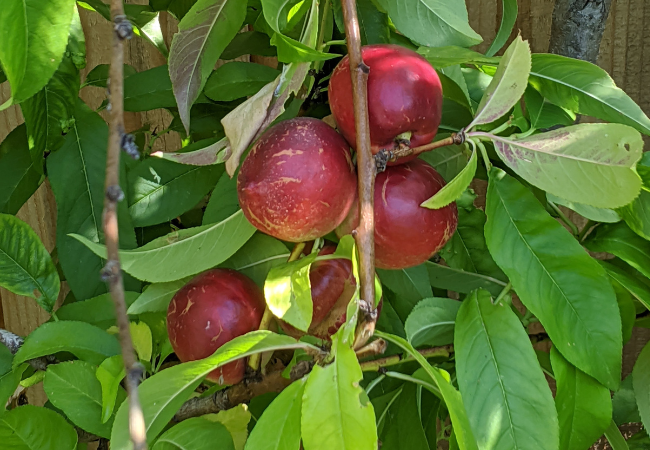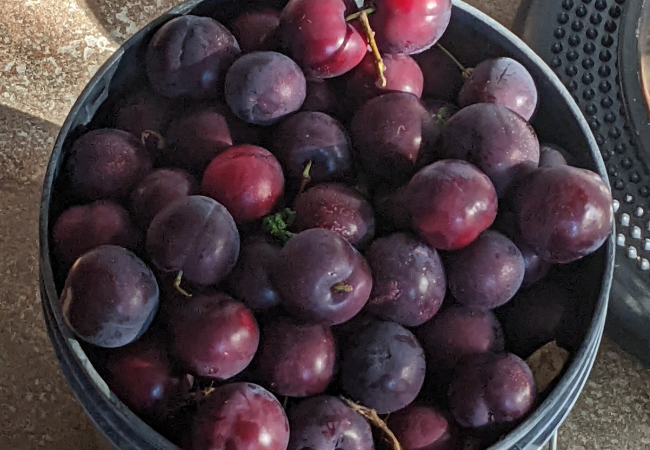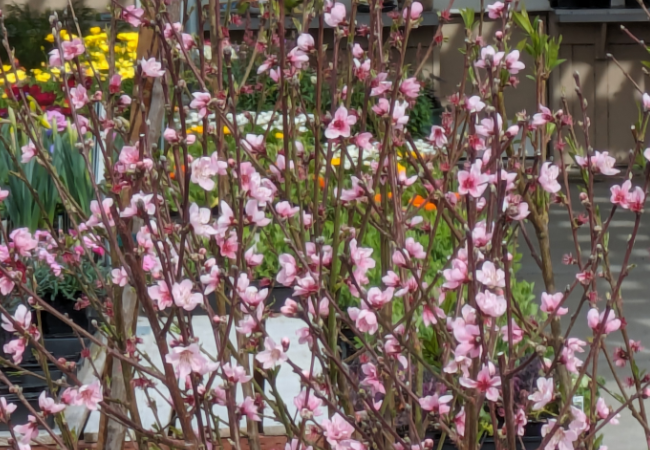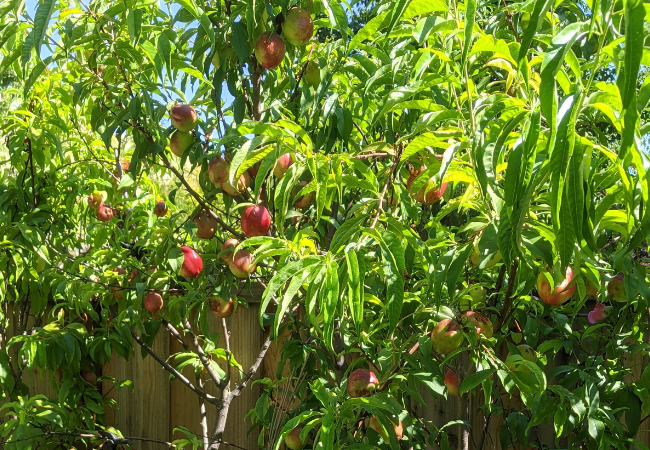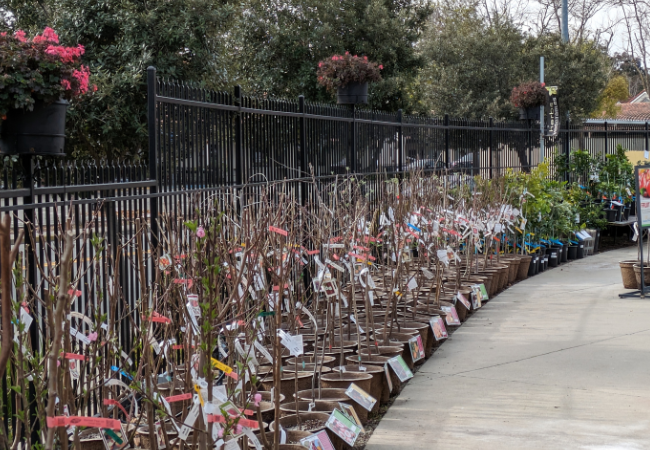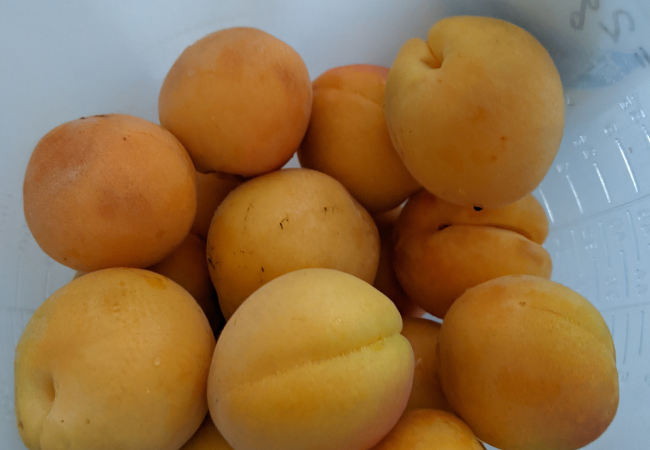Planting fruit trees is a rewarding and sustainable endeavor that brings the joy of fresh, homegrown fruit to your household. However, selecting the right fruit trees for your garden requires careful consideration of some key factors to ensure a bountiful harvest for decades. To help you embark on this fruitful journey, I have compiled a comprehensive checklist that covers essential factors to consider when picking out fruit trees from a nursery.
√ Choice of Type of Fruit
Choose fruit that you and your family enjoy eating. This may seem obvious but keep in mind that there will be times when you have an abundance of fruit. This will likely be far more fruit than your household can eat even if it's your favorite. My experience is that neighbors are very grateful to receive free fruit. Excess fruit can also be donated to food banks and churches. Look here to identify potential food donation localities near you.
√ Climate Compatibility
Your climate is a key consideration. Different fruit trees thrive in different climatic zones. Consult the USDA Hardiness Zone map to determine the climate zone of your region and choose fruit trees that are well suited to that zone. Review the USDA 2023 Hardiness Zone by zip code to check your neighborhood.
Checking the hardiness zone ensures that your tree can withstand the local temperature extremes. This is also important when considering chill hours which I will discuss below.
√ Soil
Most fruit trees thrive in deep, well-draining, granular soil with a slightly acidic to neutral pH (6.0-7.5). Amend the soil as necessary. Adding compost to the soil will help provide a slow-release fertilizer and help build the soil structure. However, do not replace all of the native soil, which may cause the tree to be root-bound. Use this blog as your guide to amending your soil to provide the optimal environment for your fruit tree.
It is important to recognize that some fruit trees have unique soil requirements. For example, blueberry bushes prefer more acidic soil in the pH range of 4.5-5.5. The normal neutral pH for soil is pH 7. Amendments can be added to the soil to make it acidic, such as sulfur. However, planting blueberries and other acid-loving fruit in containers allows for easier control of the soil pH.
√ Space Availability
Consider the available space in your garden. Fruit trees vary in size. Ensure you have enough room for the tree to grow to its mature size without overcrowding or competing with nearby plants. Fruit trees come in dwarf, semi-dwarf and standard (full) size. Look at the tag carefully for size information. Even a dwarf fruit tree can often still grow more than 8-10 feet, semi-dwarf trees up to 15+ feet tall and standard fruit trees up to 20-25+ feet. Dwarf or semi-dwarf varieties are suitable for smaller spaces, while standard varieties will be appropriate for larger areas.
√ Pollination Requirements
Some fruit trees require cross-pollination with another compatible tree to produce fruit. The tag will indicate whether the tree is “self-fruitful” or requires cross-pollination (sometimes referred to as “self-unfruitful”). For trees requiring cross-pollination check carefully which varieties are better for cross-pollinating than others. Sweet cherry fruit trees often require cross-pollination. The Bing cherry, for example, will require cross-pollination with another variety such as Stella or Sunburst varieties (which are self-fruitful).
Research the pollination requirements of the specific fruit tree you're interested in and ensure you have enough space for at least two trees if a pollinator is necessary. Alternatively, self-pollinating varieties are often available for those with limited space.
√ Chill Hours
Chill hours refer to the cumulative hours a tree requires at temperatures between 32°F and 45°F during the winter to break dormancy and produce a normal crop of fruit. With insufficient chill hours, trees will leaf out late in the season, blossoming can be prolonged, buds may deteriorate and/or drop, and few if any flowers are produced. It's a critical factor for fruit development for many fruit species including apples, cherries, nectarines, peaches, plums, apricots, and pears. Choose fruit trees that match the average chill hours of your region to ensure successful fruiting.
To find the average chill hours in your region see the link below that provides current and past chill hours data for various regions in the Bay Area. Some fruit tree varieties may require more than 1000+ chill hours while other fruit tree varieties may require much less, for example, 200 hours. Avoid fruit tree varieties that have chill hours on the borderline for the averages in your area. Average chill hours will vary from year to year and this will avoid years of marginal harvests.
Find the chill hours for your county.
√ Pest and Disease Resistance
Investigate the susceptibility of your chosen fruit tree(s) to common pests and diseases in your area. Choose varieties known for their resistance to common diseases to minimize the need for chemical interventions and ensure a healthier, more sustainable home orchard. The tags on fruit trees will indicate any disease resistance of a particular fruit tree variety. Some types of fruit trees have fewer natural diseases than others. For example, pomegranates and persimmons have fewer disease issues than other species of fruit such as cherries, plums, and peaches. For information on the common fruit tree diseases for a particular type of fruit, the University of California Integrated Pest Management website is very useful.
√ Fruit Ripening Time
To enjoy a continuous harvest throughout the season, choose varieties of fruit trees with different harvest times for your home orchard. This ensures a steady supply of fresh fruit rather than a glut all at once. Tags on fruit trees will indicate whether the particular variety of fruit tree is “early”, “mid-season” or “late”.
For example, if one wanted to extend the time when plums are ripe, planting the plum varieties Beauty, Santa Rosa, Burgundy, and Emerald Beauty will extend the harvest time from a typical 2 weeks for any one of these varieties to 3 months collectively. This can ensure a longer period of fruit harvest, as well as more flavor variety in the plums.
By timing the type and variety of fruit ripening dates, it is possible to have some fresh fruit available from May / June (apricots) all the way into October / November (apples).
√ Quality of Nursery Stock
Purchase fruit trees from reputable nurseries. Inspect the quality of the nursery stock, looking for well-developed root systems, disease-free foliage, and a straight, healthy trunk. Avoid trees with signs of stress, damage, canker sores, and pest infestations. Often people look for fruit trees already bearing fruit. Keep in mind that once planted, it is usually recommended to remove any existing fruit from the tree to minimize shock during planting.
√ Planting, Pruning, and Training Needs
Owning fruit trees is a decades-long commitment to care for the trees. Use the information provided by the UC California Backyard Orchard site on planting your fruit trees.
The amount of care a fruit tree requires after planting will vary with the fruit type. In general, fruit trees will require some annual pruning. Research the specific needs of your chosen trees to ensure proper care to maximize fruit production. If your tree size is beyond your reach, you will require professional help pruning your fruit tree. Review information on pruning fruit trees from UCANR to give you some idea of pruning considerations.
Conclusion
Selecting fruit trees for your garden involves carefully planning and considering various factors. By following this comprehensive checklist, you'll set the foundation for a thriving home orchard that will reward you with delicious, home grown fruit for years to come. Lastly, remember that the Alameda County Master Gardener Help Desk is only an email or call away if you have any questions about fruit trees or any other gardening issue.
References
Alameda County Master Gardeners Help Desk
This blog post is brought to you by the Help Desk of the UC Master Gardeners of Alameda County.
Have a gardening question? We'll help.
You can reach us by:
- Emailing acmg@ucanr.edu. Please include a photo of the problem, if you can, plus your name, phone number, city and a description of the problem.
- Using our online form.
- By phone, during our office hours, 10 am to noon Wednesday and 11 am to 1 pm Thursday: 510-670-5645. At other times, please leave a message and we'll return your call during our office hours.
- In person at our Hayward office, during our office hours, only by appointment.
